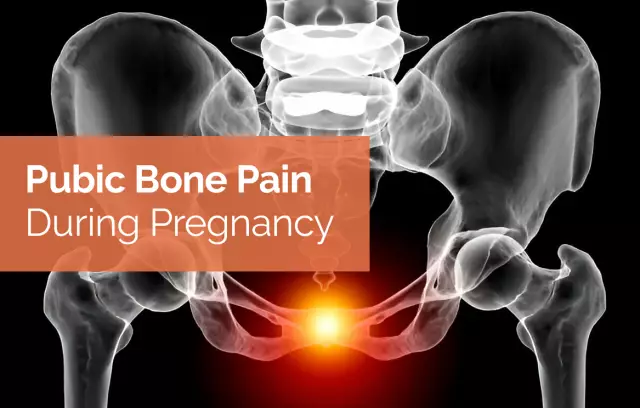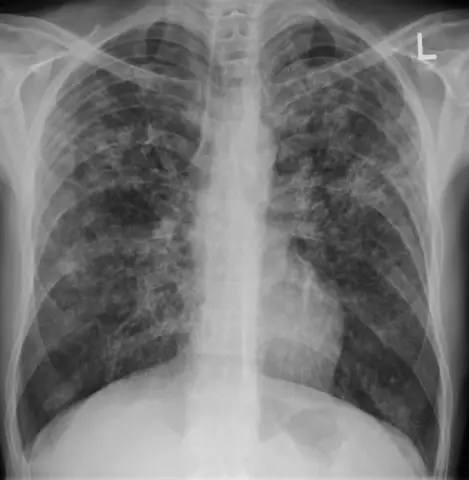- Author Rachel Wainwright [email protected].
- Public 2023-12-15 07:39.
- Last modified 2025-11-02 20:14.
Bone tuberculosis
Brief description of the disease

If a tuberculosis infection affects the spine and bone joints, then the person is diagnosed with bone tuberculosis. The disease is hematogenously transmitted from the primary lesion and most often affects children in the first 10 years of life. In most cases, tuberculosis of bones and joints develops in the pineal gland of the articular end of the bone, where, in fact, the focus of infection is formed. Then the infection spreads to the synovium and articular cartilage.
It should be noted that the disease affects various parts of the joint, therefore, experts distinguish synovial and bone tuberculosis of the bones, the symptoms of which we will describe below. In the meantime, a few words about the characteristic features of each form. Synovial tuberculosis of the bones leads to hyperemia and the appearance of many tubercles filled with serous escudate. If treatment is started on time, then the infectious process subsides almost immediately with the simultaneous healing of the expressed areas. Bone tuberculosis, which was not treated or carried out incorrectly, leads to destruction of the ligamentous apparatus and, ultimately, complete dysfunction of the articular ends of the bones.
As for bone tuberculosis, it proceeds in different ways. The disease begins either with the melting of the bone substance of the bone, or with the necrosis of significant areas of the skin, and this process begins to spread over time to an ever larger area. Regardless of the initial manifestations, bone tuberculosis of bones and joints causes the formation of a purulent fistula or cavity that opens outward. Note also that after a few weeks, the inflammatory process can stabilize and the patient is in a stable remission.
Bone tuberculosis - symptoms and clinical picture
The most characteristic symptoms of bone tuberculosis are swelling in the area of the affected joint, atrophy of soft tissues, accumulation of serous or serous-fibrinous exudate, muscle contracture and limited mobility of the articular part. X-ray examination reveals: limited cavities in the bone, bone loss and expansion or narrowing of the joint space (depending on the presence of exudate).
Bone tuberculosis - treatment of the disease
As is the case with other orthopedic diseases, the treatment of bone tuberculosis should be carried out in a complex. In the process of treatment, specialists use both conservative methods and surgical intervention. One of the most important components of the process is chemotherapy, which serves as the basis for a number of other interventions.
Treatment necessarily includes antibiotic therapy. If possible, it should begin as early as possible in order to slow down the development of the inflammatory process. Antibacterial drugs can be applied topically, intraosseously, intravenously, and intraarterially. Sometimes they are injected into abscesses and fistulas after puncture. If a person develops tuberculosis of the bones, the symptoms of which, for whatever reason, cannot be eliminated with the help of surgery, antibiotic therapy becomes the main method of treatment.

Orthopedic methods are an obligatory component of the treatment process, the purpose of which is to relieve the affected area until the spread of the inflammatory process is completely stopped. For this, the patient is prescribed bed rest in a plaster bed, after which the patient must wear a plaster, and a little later a removable corset. In recent years, the influence of orthopedic methods on the treatment of bone tuberculosis has slightly decreased due to the development of new drugs, but, nevertheless, they are still successfully used in many domestic clinics.
Surgical intervention is indicated for patients who develop pronounced destructive processes. In this case, it is desirable to eliminate the pathological focus of inflammation, which can only be done with the help of surgical methods. Various types of surgical intervention have been developed in our country. Most often, doctors perform extirpation of the joint capsule or synovectomy. Reconstructive operations are also widely used, when specialists set as their goal not only to cure bone tuberculosis, but also to restore the functions of the affected section. At the same time, complex treatment of complications that often accompany tuberculosis is carried out. After the operation, the patient is shown bed rest for some time. After its expiration, it is recommended to consolidate the results achieved and visit one of the profile sanatoriums,where the recovery process will be the fastest and most painless.
YouTube video related to the article:
The information is generalized and provided for informational purposes only. At the first sign of illness, see your doctor. Self-medication is hazardous to health!






